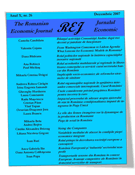Abstract:
The beginning of the 19-th century has, for the Romanian world, a specific trait, that is political instability, both within the geographical context and on the domestic level. This makes life and wealth most insecure, limits the economic private initiative as well as capital accumulation. The experience of the Romanian world, looked upon as an evolution of facts and economic deeds, together with the institutions meant to coordinate them, demonstrate that it is not a stranger to capitalism and, even more importantly, it is not incompatible with it. The period comprised between the beginning of the 19-th century and the year 1945, approximately one century and a half, represents, for the Romanian world and economy, a long series of reforms meant to install and/or consolidate the competitive economic market. The second half of the 20-th century, to be more exact the period 1945 – 1989, represented another series of reforms – in the opposite direction – meant to ensure the basis and functioning of the socialist economy. The end of 1989 marks the beginning of a new period of transition, in the contemporary meaning, a transition towards a competitive and functional market economy. First of January 2007 marks Romania’s accesion to EU, with other words the transition to normality.
